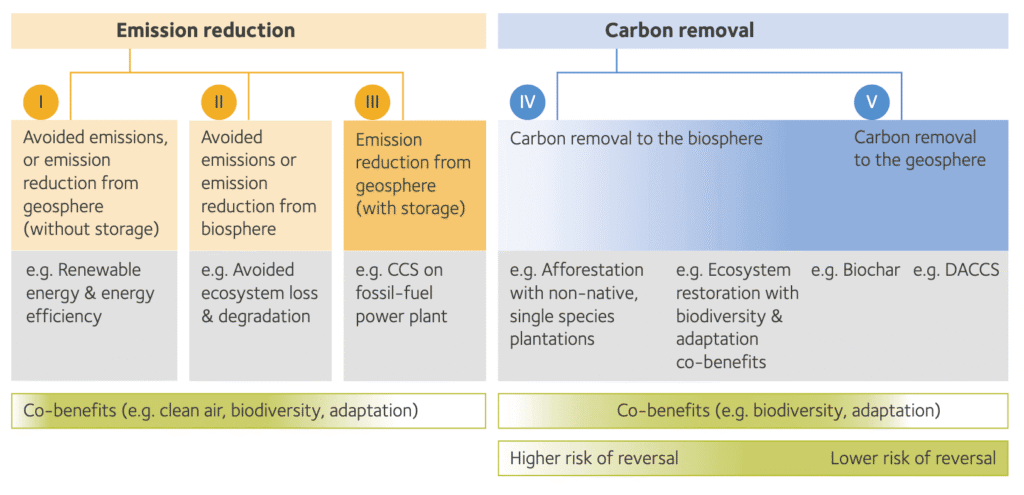Oxford Carbon Offset Types: The 5 Net Zero Project Classifications You Should Know

Why We Use the Oxford Carbon Offset Types at Coffset
At Coffset, our mission is to help users fund high-integrity climate action. To do that, we need more than just generic carbon credits—we need a clear, science-based method to classify which offset projects actually contribute to a net zero future.
That’s why we adopted the Oxford carbon offset types, as defined in the revised 2024 Oxford Principles for Net Zero Aligned Carbon Offsetting. Developed by leading climate scientists, this framework lays out the five types of offset projects based on how emissions are reduced or removed, and how carbon is stored.
In this guide, we explain each type in plain terms,so you can make informed decisions and support offsetting that actually works.

Table of Contents
The 5 Oxford Carbon Offset Types, Explained
The Oxford framework divides offset projects into emission reductions (Types I–III) and carbon removals (Types IV–V). Only carbon removals with durable storage can fully offset residual emissions to reach net zero.
Type I — Avoided Fossil Emissions (Geosphere)
- Category: Emission reduction without storage
- Example: Replacing coal power with solar or wind
- Durability: ✘ None (no storage)
- Risk of Reversal: ✔ Low
- Oxford net zero aligned?: ✘ No
These projects reduce future emissions by replacing fossil fuels with low- or zero-carbon alternatives, such as solar, wind, hydro, or improved energy efficiency. They play a major role in the decarbonization of power systems, especially in countries still heavily reliant on coal or gas.
While essential for reducing global emissions today, these types of carbon credits do not remove existing CO₂ from the atmosphere or offer any long-term storage. Therefore, they are considered short-term mitigation tools, not valid instruments for offsetting residual emissions in a net zero-aligned portfolio.
Type II — Avoided Ecosystem Loss (Biosphere)
- Category: Emission reduction in ecosystems
- Example: Forest conservation, REDD+
- Durability: ⚠ Medium (depends on governance and climate)
- Risk of Reversal: ⚠ Medium to High
- Oxford net zero aligned?: ✘ No (supportive only)
These credits come from projects that protect existing carbon sinks—like forests, wetlands, or peatlands, from destruction. A typical example is REDD+, which aims to reduce deforestation and forest degradation, often in tropical regions.
While these credits support biodiversity and Indigenous livelihoods, the Oxford Principles caution that they come with a high reversal risk. Fires, land-use change, and political instability can erase the stored carbon, making this project type unsuitable for long-term compensation of emissions, though they remain valuable for beyond value chain mitigation.
Type III — Emission Reductions with Storage (Fossil CCS)
- Category: Emission reduction with geological storage
- Example: Carbon capture and storage (CCS) at industrial sites
- Durability: ✔ High
- Risk of Reversal: ✔ Low
- Oxford net zero aligned?: ⚠ Partially (context-specific)
Projects in this category include capturing CO₂ emissions at industrial sources, such as cement plants, refineries, or power stations, and injecting that CO₂ deep underground into geological reservoirs. This permanently prevents fossil carbon from entering the atmosphere.
The Oxford Principles acknowledge this type as an important bridge solution, especially for hard-to-abate sectors. However, since the captured CO₂ would not have been emitted yet, this is still considered a reduction, not a removal. Its role in offsetting must therefore be complementary, not central, to a net zero plan.
Type IV — Carbon Removal to the Biosphere
- Category: Removal stored in nature
- Examples: Reforestation, soil carbon, blue carbon
- Durability: ⚠ Medium
- Risk of Reversal: ⚠ Medium
- Oxford net zero aligned?: ✔ Yes, if long-term and verifiable
This category includes projects like reforestation, soil carbon enrichment, or mangrove restoration, which absorb CO₂ through natural processes and store it in biomass and soil. These projects also contribute to ecosystem services, water retention, and local climate resilience.
However, their storage durability depends on long-term governance, local community involvement, and protection from climate risks like wildfire or drought. Oxford considers them valid for net zero only when backed by strong monitoring and when the risk of reversal is well-managed. They are an essential mid-term removal solution while more durable technologies scale up.
Type V — Carbon Removal to the Geosphere
- Category: Removal stored in geological formations
- Examples: Direct Air Capture (DACCS), mineralisation
- Durability: ✔ Very High
- Risk of Reversal: ✔ Very Low
- Oxford net zero aligned?: ✔ Yes (preferred)
These are advanced solutions such as Direct Air Capture with Carbon Storage (DACCS) or enhanced mineral weathering, which remove CO₂ from ambient air and sequester it underground or in solid mineral forms. This method is engineered for permanence and not dependent on fragile ecosystems.
The Oxford framework defines these as the only universally net zero-aligned offset type with near-permanent storage and ultra-low reversal risk. While today’s availability is limited and costs are high, scaling this category is critical to reaching and sustaining net zero. Early adopters, like Coffset users, help drive demand and innovation in this essential sector.
Summary Table: Oxford Carbon Offset Types at a Glance
| Type | Category | Storage | Durability | Reversal Risk | Net Zero Aligned? |
|---|---|---|---|---|---|
| I | Avoided fossil emissions | None | ✘ Low | ✔ Low | ✘ No |
| II | Avoided ecosystem loss | Biological | ⚠ Variable | ⚠ Medium-High | ✘ No (supportive only) |
| III | Fossil CCS | Geological | ✔ High | ✔ Low | ⚠ Context-dependent |
| IV | Removal to biosphere | Biological | ⚠ Medium | ⚠ Medium | ✔ If long-term durable |
| V | Removal to geosphere | Geological | ✔ Very High | ✔ Very Low | ✔ Yes (preferred) |
Why It Matters for Your Offsetting Strategy
The Oxford Principles make one thing clear: by 2050, offsetting must come entirely from carbon removals (Types IV and V), and especially those with durable storage.
At Coffset, we’re committed to:
- Prioritizing removal-based offsets
- Ensuring durability and verification
- Offering transparency about what type of project you’re supporting
How This Fits Into Your Climate Journey
Understanding the Oxford carbon offset types is just one part of the bigger picture. If you haven’t already, try our carbon footprint calculator to estimate your own emissions, monthly, or per trip. Once you know your footprint, you’ll be able to choose the right offset type based on your goals and values.
FAQ: Oxford Carbon Offset Types
Q: Are all carbon credits valid for net zero?
A: No. Only carbon removals with durable storage (Types IV and V) qualify under the Oxford Principles.
Q: Can I still support avoided deforestation?
A: Yes, as a way to help nature and biodiversity. But those credits should not be used to claim net zero.
Q: Why does Coffset follow this classification?
A: Because the Oxford carbon offset types are the most credible, science-backed method to ensure climate claims are real.
Final Word: Offset Smarter, Not Just More
Most offsets in the market today don’t meet Oxford’s net zero standards. At Coffset, we’re working to change that by helping users invest in real carbon removals, verified durability, and projects with purpose. If you want to support climate action with integrity, start by choosing the right type of offset.
Explore our offsetting options and join the shift to net zero-aligned impact.
Read the Oxford Principles for Net Zero Aligned Carbon Offsetting (revised 2024).